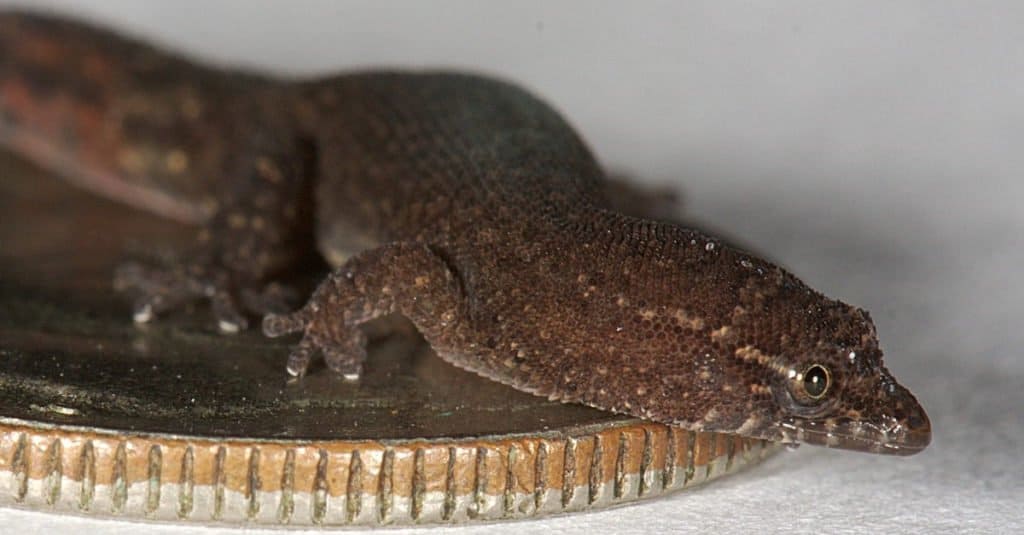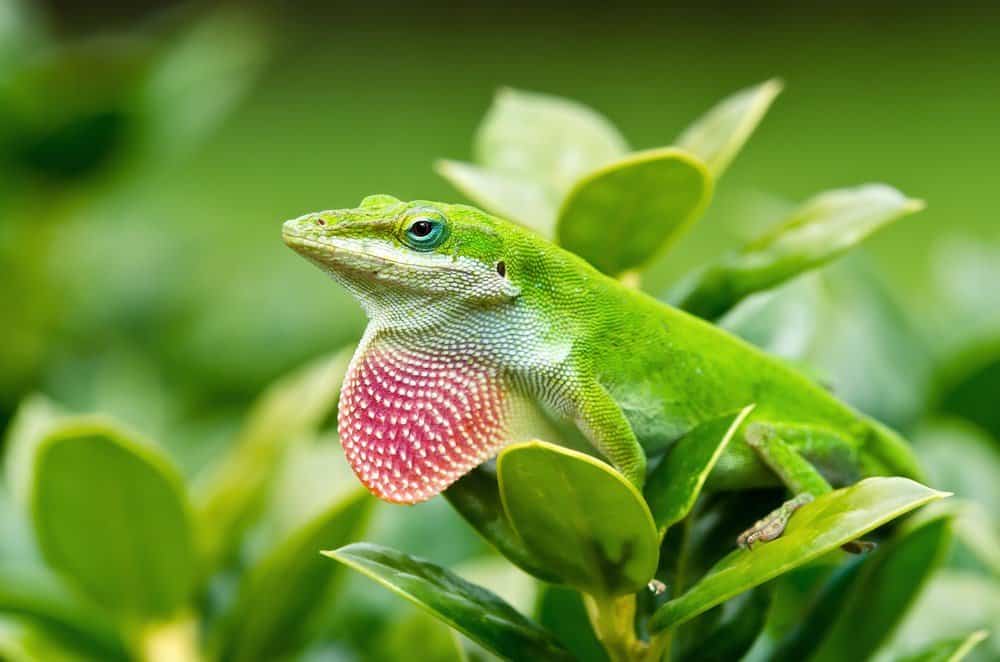Species of small lizard can be divided into the small (under ten inches), and the absolutely tiny (less than one inch). Small lizards live all over the world, in a variety of habitats. They make popular pets, and many are relatively easy to care for. If you’re thinking about getting a small lizard as a pet or, or if you’re just curious, you may be asking; just what do small lizards eat?
Here, we’ll learn about the diets of several species of small lizard, all the way from the tiniest of the tiny to the most popular pet small lizards. Then, we’ll take a look at how these diets compare, and just where all of these small lizards live. Finally, we’ll go over the care and feeding of your pet small lizard, and talk a little more about what kinds of animals prey on small lizards.
Small Lizards: Their Diet Explained

The
Virgin Islands dwarf
sphaero eats mites and other tiny insects
©Alejandro Sánchez / CC BY-SA 3.0 – License
Most small lizards are between 3-10 inches long, but a few species are so small that they can fit on the tip of your finger. Just what does something so tiny eat? Here, we’ll analyze the diets of three of the smallest lizards in the world.
The world’s smallest lizard, and smallest reptile, is the nano-chameleon (Brookesia nano). This lizard lives in northern Madagascar, and measures in at just over half an inch. Female nano-chameleons are slightly larger than males. Nano-chameleons eat mites, and are primarily carnivores.
The Virgin Islands dwarf sphaero (Sphaerodactylus parthenopion) is nearly as small as the nano-chameleon at less than an inch long. This tiny lizard is native to the British Virgin Islands and, like the nano-chameleon, survives on very small insects. The Virgin Islands dwarf sphaero eats mites and other tiny insects; it is primarily carnivorous.
Another of the world’s tiny lizards is the Jaragua lizard (Sphaerodactylus ariasae). This lizard is also less than an inch long and is native to a few islands in the Dominican Republic. Jaragua lizards eat small insects like aphids and mites, they are carnivores.
What Do Wild Small Lizards Eat?
Lizards are highly adaptable and range in size from less than an inch to as big as a human, in the case of the komodo dragon. Some of the smallest species of lizard, those less than ten inches in length, make the most popular pets. But their diets in captivity can differ vastly from their diets in the wild.
Small lizards eat everything from small insects like grasshoppers and ants to fruit, pollen, and nectar. They are primarily either omnivores or carnivores, and are mostly insectivorous.
Small lizards can be found all over the world, including North America, Southeast Asia, Africa, New Caledonia, and the Middle East. They live in a variety of habitats ranging from lush tropical rainforests to dry, desert grasslands. Where they live determines what they eat, and how they hunt.
Most small lizards hunt using a combination of opportunism and ambush predation. Some will even leap into the air to catch flying insects with their long, sticky tongues. Small lizards can run fast when they see something good to eat, and may sprint at small insects to catch them.

Small
lizards eat
mostly small insects like grasshoppers, flies, and ants; they are primarily carnivores
©Leena Robinson/Shutterstock.com
Though each species of small lizard feeds on its own set of prey items, they have a few things in common when it comes to their favorite things to eat:
- Crickets
- Grasshoppers
- Flies
- Butterflies
- Moths
- Beetles
- Spiders
- Cockroaches
- Aphids (for tiny lizards)
- Mites (for tiny lizards)
- Earth worms
- Termites
- Ants
- Fruit
- Nectar
- Pollen
- Seeds
Less commonly, and only for the largest of the small lizards, they will also eat smaller lizards and baby rodents. Small lizards are mostly insectivorous, but many supplement their diets with fruit, nectar, pollen, and seeds.
What Do Different Types of Small Lizard Eat?
There are many species of small lizard, here are a few of the most common, and their favorite foods.
- Green anole (Anolis carolinensis): crickets, grasshoppers, flies, butterflies, moths, cockroaches, beetles, spiders, seeds
- Leopard gecko (Eublepharis macularius): crickets, grasshoppers, meal worms, baby mice, small lizards
- Crested gecko (Correlophus ciliatus): crickets, grasshoppers, fruit, nectar, pollen.
- Gold dust day gecko (Phelsuma laticauda): flies, grasshoppers, crickets, fruit, nectar, pollen
- Long tailed gecko (Takydromus sexlineatus): flies, crickets, grasshoppers, smaller lizards
- Texas horned lizard (Phyrnosoma cornutum): harvester ants (up to 1,000 per day)
What to Feed Your Pet Small Lizard

Small lizards make great pets, they eat grasshoppers, crickets, meal worms, and many other insects.
©Choke12/Shutterstock.com
Small lizards are one of the most popular pet reptiles. They don’t outgrow their cages, and several species, including geckos and anoles, are easy to take care of. But just what should you feed your pet lizard?
Small lizards eat grasshoppers, crickets, meal worms, earthworms, ants, flies, and just about any other bug you give to them; as long as it’s small enough. Avoid feeding your lizard anything bigger than its head, and, be sure not to leave any uneaten bugs overnight. Some people even feed baby mice, or ‘pinkies’, to their pet lizards.
Small pet lizards also need a clean environment, a fresh source of water, heat, and humidity to thrive. Depending on what kind of lizard you have, you may also need to give it calcium supplements. No matter what kind of small lizard you choose, be sure to consult an expert on the proper care and feeding of your new pet.
What Animals Eat Small Lizards?
Because small lizards are, well, so small—they tend to get eaten by predators like bigger lizards, snakes, birds, jackals, cats, dogs, wolves, and even spiders. Small lizards have a variety of defenses against predators, including losing and regrowing their tails to escape. One small lizard, the Texas horned lizard, even squirts blood from its eyes to deter would be predators.
The photo featured at the top of this post is © Choke12/Shutterstock.com
Thank you for reading! Have some feedback for us? Contact the AZ Animals editorial team.






